| Revision as of 05:01, 25 September 2013 view sourceStrebe (talk | contribs)Extended confirmed users8,422 edits Removing “historical” from “map projections”. Corrected descriptions. Removed material that was confusing or that adds little.← Previous edit | Revision as of 00:29, 27 September 2013 view source Czixhc (talk | contribs)645 editsNo edit summaryNext edit → | ||
| Line 1: | Line 1: | ||
| {{About|maps of the Earth}} | {{About|maps of the Earth}} | ||
| {{refimprove|date=May 2013}} | {{refimprove|date=May 2013}} | ||
| ], |
], 1689]] | ||
| ⚫ | ] and the ], it is considered to be a low-error map projection<ref>'''', 2007, David M. Goldberg & ] III, 2007, V42 N4.</ref> adopted by the ] for reference maps.]] | ||
| ], 1689]] | |||
| A '''world map''' is a ] of most or all of the surface of the ]. World maps form a distinctive category of maps due to the problem of ]. Maps by necessity distort the presentation of the earth's surface. These distortions reach extremes in a world map. The many ways of projecting the earth reflect diverse technical and æsthetic goals for world maps.<ref name="ACA1988"> | A '''world map''' is a ] of most or all of the surface of the ]. World maps form a distinctive category of maps due to the problem of ]. Maps by necessity distort the presentation of the earth's surface. These distortions reach extremes in a world map. The many ways of projecting the earth reflect diverse technical and æsthetic goals for world maps.<ref name="ACA1988"> | ||
| {{cite book | {{cite book | ||
| Line 18: | Line 18: | ||
| ==Map projections== | ==Map projections== | ||
| ⚫ | ], a low-error map projection<ref>'''', 2007, David M. Goldberg & ] III, 2007, V42 N4.</ref> adopted by the ] for reference maps.]] | ||
| {{Main|Map projection|List of map projections}} | {{Main|Map projection|List of map projections}} | ||
| Line 25: | Line 24: | ||
| <gallery widths="175px"> | <gallery widths="175px"> | ||
| Image:World Map flat Mercator.png | ] | Image:World Map flat Mercator.png | ] | ||
| File:Mollweide projection SW.jpg | ] | |||
| Image:Cahill Butterfly Map.jpg | ] | Image:Cahill Butterfly Map.jpg | ] | ||
| <!-- Deleted image removed: Image:Waterman_Butterfly_Map_1996.jpg | ] --> | <!-- Deleted image removed: Image:Waterman_Butterfly_Map_1996.jpg | ] --> | ||
| Line 31: | Line 29: | ||
| File:Azimuthal equidistant projection SW.jpg|] azimuthal equidistant projection | File:Azimuthal equidistant projection SW.jpg|] azimuthal equidistant projection | ||
| Image:Blank-map-world-south-up.png|A ] | Image:Blank-map-world-south-up.png|A ] | ||
| ⚫ | Image:BlankMap-World-162E-flat.svg | ]-centric map (more commonly used in ]n countries and ]) | ||
| </gallery> | </gallery> | ||
| Line 41: | Line 40: | ||
| Image:Elevation.jpg | ] map | Image:Elevation.jpg | ] map | ||
| Image:CIA WorldFactBook-Political world.pdf| A simple political map of the world as of 2011 | Image:CIA WorldFactBook-Political world.pdf| A simple political map of the world as of 2011 | ||
| ⚫ | Image:BlankMap-World-162E-flat.svg | ]-centric map (more commonly used in ]n countries and ]) | ||
| Image:AYool topography 15min.png | Present day ] ] and ] (]) | Image:AYool topography 15min.png | Present day ] ] and ] (]) | ||
| Image:World map.png | ] map of the world | Image:World map.png | ] map of the world | ||
| File:World map by skin color for modern populations.jpg| Map representing the effects of human displacement trends in the last centuries. | |||
| File:CO2 responsibility 1950-2000.svg | map of anthropogenic CO<sub>2</sub> emission by country | File:CO2 responsibility 1950-2000.svg | map of anthropogenic CO<sub>2</sub> emission by country | ||
| File:UN Human Development Report 2008.svg | UN Human Development Index by country as of 2008 | File:UN Human Development Report 2008.svg | UN Human Development Index by country as of 2008 | ||
| Line 61: | Line 60: | ||
| File:Claes Janszoon Visscher - Nova Totius Terrarum Orbis Geographica Ac Hydrographica Tabula Autore'.jpg | 1652 world map by Visscher | File:Claes Janszoon Visscher - Nova Totius Terrarum Orbis Geographica Ac Hydrographica Tabula Autore'.jpg | 1652 world map by Visscher | ||
| File:Radkarte MKL1888.png|Ideal reconstruction of medieval world maps (from ''Meyers Konversationslexikon'', 1895) (Asia shown on the right) | File:Radkarte MKL1888.png|Ideal reconstruction of medieval world maps (from ''Meyers Konversationslexikon'', 1895) (Asia shown on the right) | ||
| File:Anaximander world map-it.svg|Hypothetical reconstruction of the world map of |
File:Anaximander world map-it.svg|Hypothetical reconstruction of the world map of | ||
| Image:OrteliusWorldMap1570.jpg|An historical map of the world by ], 1570 | |||
| ] (610–546 BC) | |||
| </gallery> | </gallery> | ||
| </center> | </center> | ||
Revision as of 00:29, 27 September 2013
This article is about maps of the Earth. For other uses, see World map (disambiguation).| This article needs additional citations for verification. Please help improve this article by adding citations to reliable sources. Unsourced material may be challenged and removed. Find sources: "World map" – news · newspapers · books · scholar · JSTOR (May 2013) (Learn how and when to remove this message) |


A world map is a map of most or all of the surface of the Earth. World maps form a distinctive category of maps due to the problem of projection. Maps by necessity distort the presentation of the earth's surface. These distortions reach extremes in a world map. The many ways of projecting the earth reflect diverse technical and æsthetic goals for world maps.
World maps are also distinct for the global knowledge required to construct them. A meaningful map of the world could not be constructed before the European Renaissance because less than half of the earth's coastlines, let alone its interior regions, were known to any culture. New knowledge of the earth's surface has been accumulating ever since and continues to this day.
Maps of the world generally focus either on political features or on physical features. Political maps emphasize territorial boundaries and human settlement. Physical maps show geographic features such as mountains, soil type or land use. Geological maps show not only the surface, but characteristics of the underlying rock, fault lines, and subsurface structures. Choropleth maps use color hue and intensity to contrast differences between regions, such as demographic or economic statistics.
Map projections
Main articles: Map projection and List of map projectionsA map is made using a map projection, which is any method of representing a globe on a plane. All projections distort distances and directions, and each projection distributes those distortions differently. Perhaps the most well known projection is the Mercator Projection, originally designed as a nautical chart.
-
 Mercator projection
Mercator projection
-
 B. J. S. Cahill Butterfly Map, 1909, from 1919 pamphlet
B. J. S. Cahill Butterfly Map, 1909, from 1919 pamphlet
- Dymaxion projection Dymaxion projection
-
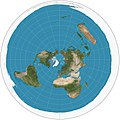 Polar azimuthal equidistant projection
Polar azimuthal equidistant projection
-
 A south-up map
A south-up map
-
 Pacific-centric map (more commonly used in East Asian countries and Australia)
Pacific-centric map (more commonly used in East Asian countries and Australia)
Thematic maps
Further information: Thematic mapA thematic map shows geographic information about one or a few focused subjects. These maps "can portray physical, social, political, cultural, economic, sociological, agricultural, or any other aspects of a city, state, region, nation, or continent".
-
 Clickable world map (with climate classification)
Clickable world map (with climate classification)
-
 Elevation map
Elevation map
-
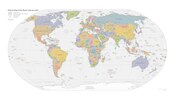 A simple political map of the world as of 2011
A simple political map of the world as of 2011
-
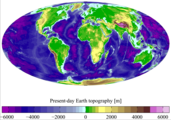 Present day Earth altimetry and bathymetry (Mollweide projection)
Present day Earth altimetry and bathymetry (Mollweide projection)
-
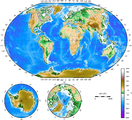 Topographical map of the world
Topographical map of the world
- Map representing the effects of human displacement trends in the last centuries. Map representing the effects of human displacement trends in the last centuries.
-
 map of anthropogenic CO2 emission by country
map of anthropogenic CO2 emission by country
-
 UN Human Development Index by country as of 2008
UN Human Development Index by country as of 2008
-
 World map showing life expectancy
World map showing life expectancy
-
 Volcano map
Volcano map
-
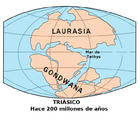 world map showing the continents as of 200 million years ago (Triassic period)
world map showing the continents as of 200 million years ago (Triassic period)
Historical maps
Further information: Early world mapsEarly world maps cover depictions of the world from the Iron Age to the Age of Discovery and the emergence of modern geography during the early modern period. Old maps provide much information about what was known in times past, as well as the philosophy and cultural basis of the map, which were often much different from modern cartography. Maps are one means by which scientists distribute their ideas and pass them on to future generations.
-
 World map according to Posidonius (150–130 BC), drawn in 1628.
World map according to Posidonius (150–130 BC), drawn in 1628.
-
 Tabula Rogeriana world map by Muhammad al-Idrisi in 1154. Note that north is to the bottom
Tabula Rogeriana world map by Muhammad al-Idrisi in 1154. Note that north is to the bottom
-
 1652 world map by Visscher
1652 world map by Visscher
-
 Ideal reconstruction of medieval world maps (from Meyers Konversationslexikon, 1895) (Asia shown on the right)
Ideal reconstruction of medieval world maps (from Meyers Konversationslexikon, 1895) (Asia shown on the right)
-
 Hypothetical reconstruction of the world map of
Hypothetical reconstruction of the world map of
-
 An historical map of the world by Ortelius, 1570
An historical map of the world by Ortelius, 1570
See also
- Blank maps of the world for historical use
- Misplaced Pages's Clickable world map
- Continental drift
- European Digital Archive on Soil Maps of the World
- Global Map
- Globe
- International Map of the World
- List of World Map changes
- Mappa mundi
- OneGeology
- Time zone
- World Map at Lake Klejtrup
References
- Large-Scale Distortions in Map Projections, 2007, David M. Goldberg & J. Richard Gott III, 2007, V42 N4.
- American Cartographic Association's Committee on Map Projections (1988). Choosing a World Map. Falls Church: American Congress on Surveying and Mapping. pp. 1–2.
- Thematic Maps Map Collection & Cartographic Information Services Unit. University Library, University of Washington. Accessed 27 Dec 2009.
- http://academic.emporia.edu/aberjame/map/h_map/h_map.htm
Further reading
- Edson, Evelyn (2011). The World Map, 1300–1492: The Persistence of Tradition and Transformation. JHU Press. ISBN 1421404303
- Harvey, P. D. A. (2006). The Hereford world map: medieval world maps and their context. British Library. ISBN 0712347607
External links
- Java applet to show distortion in world maps
- Java world map allowing different projections and orientations
- World maps from the CIA World Factbook
- World maps in PDF format
- GinkgoMaps—free digital world maps published under the CC-by License
- World map at WikiMapia
- Full-screen pan and zoom world map
| Satellite navigation | |
|---|---|
| Systems | |
| Devices | |
| Chipsets |
|
| GNSS augmentation | |
| Protocols | |
| Technology | |
| Geographic services | |
| Related topics | |